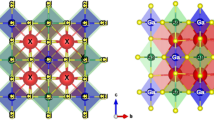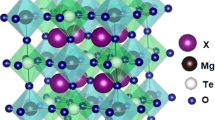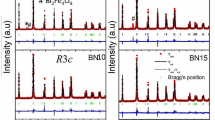Abstract
The Raman scattering spectra of isostructural Bi2O3 and Bi1.8Tm0.2O3 in the course of heating have been investigated. It is shown that the sequences of structural changes with increase in temperature differ: α → δ and δ* → β → δ, respectively. In the high‐temperature region, the structure takes the form of a disordered cube irrespective of the previous history of specimens.
Similar content being viewed by others
REFERENCES
V. G. Keramidas and W. B. White,J. Chem. Phys., 59, 1561–1562 (1973).
H. Arashi and B. Pirion, High-Temperature, High-Pressure, 11, 399–405 (1979).
V. N. Strekalovskii, Yu. M. Polezhaev, and S. F. Pal'guev, Oxides with Impurity Disordering: Composition, Structure, Phase Transformations [in Russian], Moscow (1987).
H. Iwahara, T. Esaka, T. Sato, and T. Takahashi, J. Solid State Chem., 39, 173–180 (1981).
L. V. Glinskikh, V. N. Strekalovskii, G. Sh. Shekhtman, O. V. Sivtsova, É. G. Vovkotrub, and V. G. Bamburov, Materialovedenie, 3, 41–45 (2001).
N. M. Sammes, G. A. Tompsett, H. Näfe, and F. Aldinger, J. Eur. Ceram. Soc., 19, 1801–1826 (1999).
Author information
Authors and Affiliations
Corresponding author
Rights and permissions
About this article
Cite this article
Ermakova, L.V., Strekalovskii, V.N., Vovkotrub, É.G. et al. Structural Transformations in a Bi2O3 Crystal and in Bi2O3‐Based Solid Solutions in the Temperature Interval 25–750°C. Journal of Applied Spectroscopy 69, 152–154 (2002). https://doi.org/10.1023/A:1015396716886
Issue Date:
DOI: https://doi.org/10.1023/A:1015396716886




